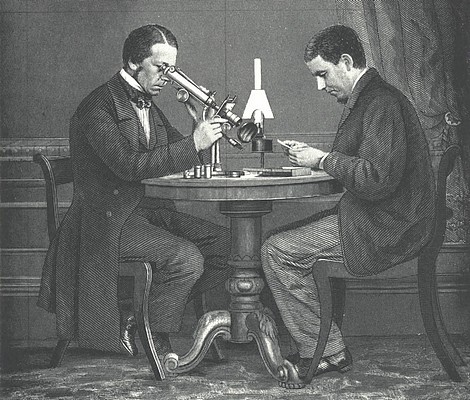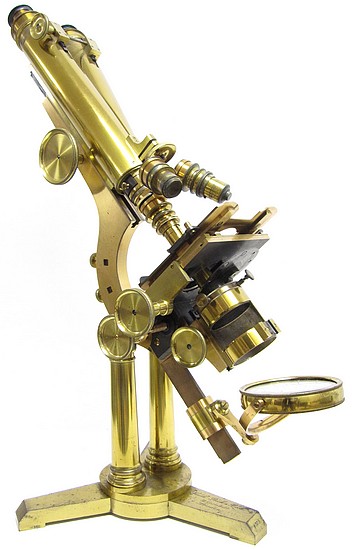
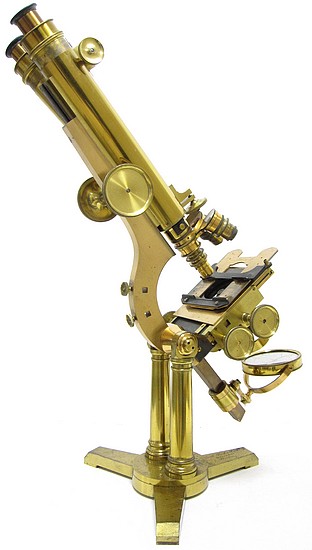
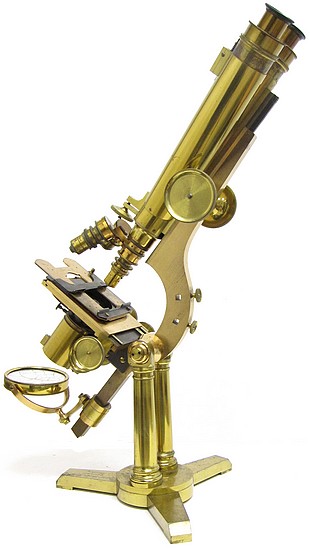
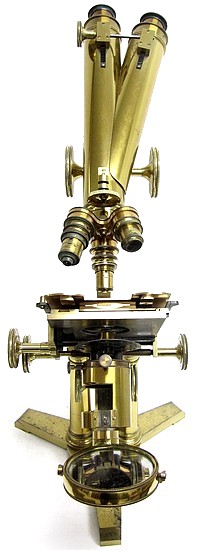

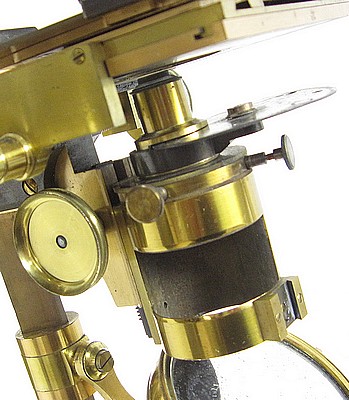
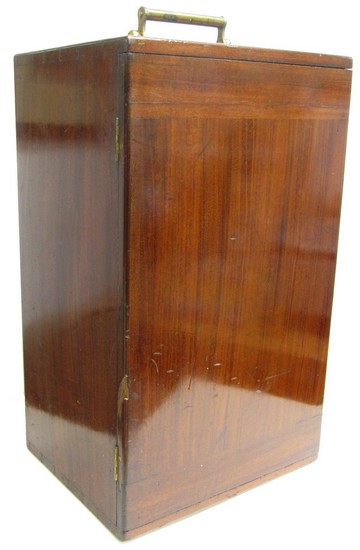
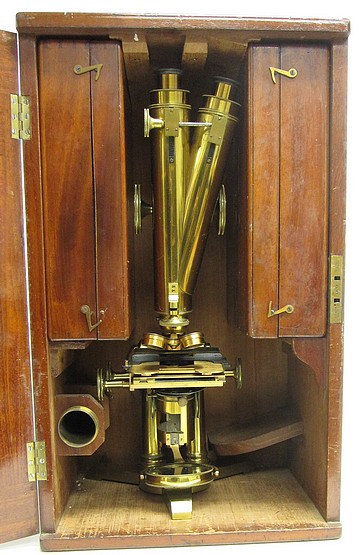
This microscope is signed
on one foot of the tripod base Smith, Beck
& Beck, 31 Cornhill, London, #4375. It is
an example of the Smith, Beck & Beck "Large
Best" or No. 1 model
microscope dating from 1866. This was the
top-of-the-line model produced by the firm at the
time.
The firm was established
by James Smith, one of the three premier English
microscope manufacturers of the Victorian era (the two
others were A. Ross and H. Powell), around 1839. In
1847, Richard Beck became a partner in the firm and was
shortly followed by his brother Joseph Beck in 1857.
After the retirement of Smith in 1865, the firm was
known as R&J Beck.
The microscope is
constructed in brass with a bright lacquered surface
finish and is about 19 inches tall when set up for use
with the draw tubes partially extended as shown in some
of the photos. The main focus is by rack and pinion and
the fine focus is by calibrated micrometer screw
operating on the nosepiece. The interocular separation
is adjusted by moving the draw tubes with rack and
pinion. The substage is focused by rack and pinion and
can accommodate the various accessories supplied with
the microscope. The microscope is equipped with a
mechanical stage having orthogonal motions. The upper
plate with slide holder can rotate in the optical axis.
The instrument is supported by double pillars and can
rotate upon the tripod base. The accessories associated
with the microscope can be identified with reference to
the later
R. & J. Beck 1882 catalog.
The following was extract from The Microscope and Its Revelations William B. Carpenter, 1856
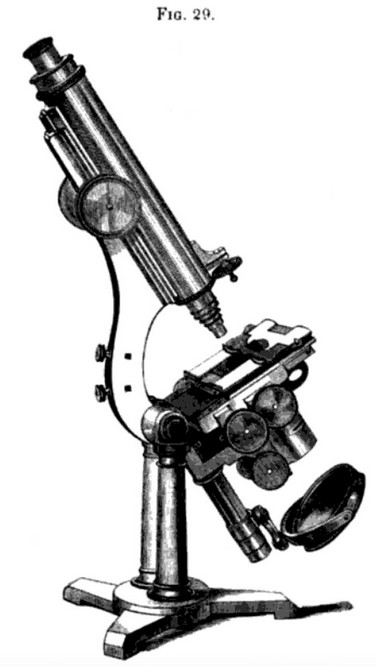
Smith and Beck's Large Microscope.—The general plan of this instrument (Fig. 29)
nearly resembles that of the “dissecting microscope” of the same makers, already noticed,
so far, at least, as regards the mode of supporting the body, and of effecting the focal
adjustments; whilst in the construction of the stage, and in the arrangement of the
fittings beneath, it differs from all the microscopes hitherto described. The stage
is furnished with the usual traversing movements; but it is distinguished by its thinness;
and this is of importance in certain cases, as admitting of a more oblique
illumination than could otherwise be obtained, and also as allowing the construction
of the achromatic condenser to be much simplified. The platform for the object is
fitted upon the traversing apparatus, in the same mode as in the microscope last
described, and possesses the same kind of rotatory movement. Beneath the stage
is a continuation of the gun-metal limb which carries the body and this is ploughed
out into a groove for the reception of a sliding-bar, which carries what may be
termed the “secondary body” namely, a short tube (seen beneath the stage), capable
of being moved up and down by a milled head, and fitted for the reception of the
achromatic condenser, polarizing apparatus, etc. This “secondary body” consequently
answers the same purpose as the “secondary stage” of Mr. Ross’s microscope, and
its relations to the other parts of the instrument are essentially the same; but
it differs in the following particulars:—first, that by being made to work in a
groove which is in perfect correspondence with that wherein the principal “ body”
works (this correspondence being secured by the action of the planing machine
that ploughs both grooves), the “secondary” body always has its axis so perfectly
continuous with that of the first, that no special adjustment is needed to “centre”
the greater part of the illuminating apparatus ; and, secondly, that the tube will
carry the achromatic condenser at its upper end, the polarizing prism at its lower,
and the selenite plates between the two, a combination that cannot be made in any
other instrument. Moreover, as all these fittings are received into a tube of which
the exact size and position are assured, the makers of this instrument can supply
additional apparatus at any time, with the certainty of its accurate adjustment.
This “secondary body,” however, has not the rotatory movement possessed by Mr. Ross’s
“secondary stage” and to the limited class of purposes, therefore, which that
movement is adapted to serve, it cannot be adapted. The mirror is hung in the
usual way between two centres; but the semicircle that carries these, instead of
being at once pivoted to the tube which slides upon the cylindrical stem, is
attached to an intermediate arm and by means of this it may be placed in such
a position as to reflect light very obliquely upon the object, and thus to bring
out a new set of appearances, with which it is very important in certain cases
to be acquainted.
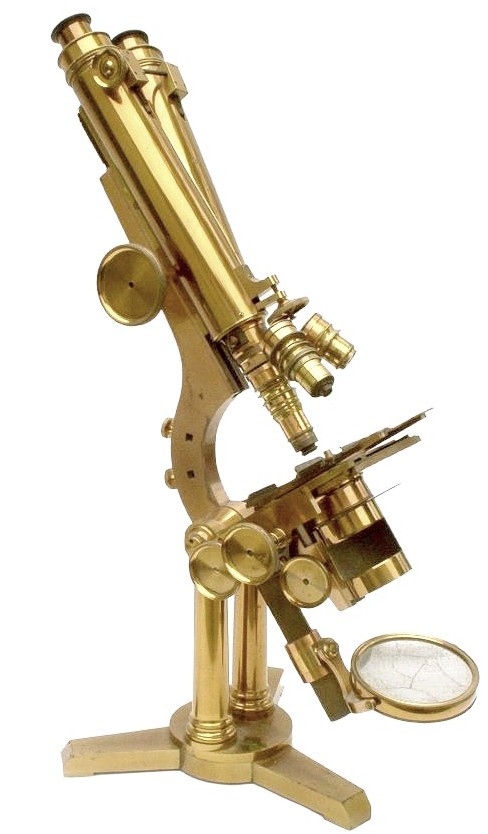
A short history of the R. & J. Beck firm








